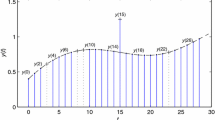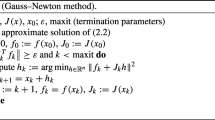Abstract
The least squares method—usually used to estimate different parameters—also leads to solving the equation \(A_{n \times n} \,\theta_{n \times 1} = y_{n \times 1}\) in system identification. The classical method (i.e., Cholesky decomposition) which is generally used to solve this problem has a computational complexity of \(O\left( {n^{3} } \right)\). As we know, a greater number of samples yields better system modeling. With a larger input data, the computational complexity increases significantly. That is the case with Generalized Least Squares error identification (GLS method) as well. The proposed approach in this article to solve the aforementioned problem is to use quantum algorithms, which significantly reduce the computational complexity. Therefore, in this study, two methods, namely Classical Quantum GLS (C-QGLS) and Quantum GLS methods (QGLS), were proposed to ease the computational complexity. Unlike HHL, these two methods can estimate unbiased parameters despite the existence of color noise. Moreover, they can handle the issue of non-hermitian and ill-condition matrices. The complexity of C-QGLS and QGLS methods is \(O\left( {{\text{poly}}\left( n \right)\,\log n} \right)\) and \(O\left( {{\text{poly}}\,\log\, (n^{2} )} \right)\), respectively. The proposed methods showed significant superiority compared to the classical methods. Their limitations were fewer than the other Quantum Methods, and their performance was also acceptable.

Similar content being viewed by others
Explore related subjects
Discover the latest articles, news and stories from top researchers in related subjects.Code availability
How to implement an example is explained in Sect. 4 of this article. For more details, the MATLAB and Python code is placed in the following link. Please refer to "https://github.com/sadeghkalantari/QGLS.git".
References
Ding, F.: Least squares parameter estimation and multi-innovation least squares methods for linear fitting problems from noisy data. J. Comput. Appl. Math. 426, 115107 (2023). https://doi.org/10.1016/j.cam.2023.115107
Eykhoff, P.: Identification theory: practical implications and limitations. Measurement 2(2), 75–85 (1984). https://doi.org/10.1016/0263-2241(84)90036-8
Nelles, O.: Nonlinear dynamic system identification. In: Nelles, O. (ed.) Nonlinear system identification: from classical approaches to neural networks, fuzzy models, and gaussian processes, pp. 831–891. Springer International Publishing, Cham (2020). https://doi.org/10.1007/978-3-030-47439-3_19
Sun, R., et al.: FedMSA: a model selection and adaptation system for federated learning. Sensors (Basel) 22(19), 7244–7244 (2022). https://doi.org/10.3390/s22197244
Kalantari, S., Abdollahifard, M.J.: Optimization-based multiple-point geostatistics: a sparse way. Comput. Geosci. 95, 85–98 (2016). https://doi.org/10.1016/j.cageo.2016.07.006
Qubits, World scientific eBooks, pp 3–30, (2018). https://doi.org/10.1142/9789813238411_0001
Kalantari, S., Madadi, A., Ramezani, M.: Reconstruction of geological images based on an adaptive spatial domain filter: an example to introduce quantum computation to geosciences. Int. J. Mining Geo-Eng. (2023). https://doi.org/10.22059/IJMGE.2023.352048.595007
Rawat, B., Mehra, N., Bist, A.S., Yusup, M., Sanjaya, Y.P.A.: Quantum computing and AI: impacts & possibilities. ADI J. Recent Innov. (AJRI) 3(2), 202–207 (2022). https://doi.org/10.34306/ajri.v3i2.656
Shor, P.W.: Algorithms for quantum computation: discrete logarithms and factoring, Proceedings 35th annual symposium on foundations of computer science, (1994). https://doi.org/10.1109/sfcs.1994.365700.
Shor, P.W.: Polynomial-time algorithms for prime factorization and discrete logarithms on a quantum computer. SIAM Rev. 41(2), 303–332 (1999). https://doi.org/10.1137/s0036144598347011
Harvey, D., van der Hoeven, J.: Integer multiplication in time O (n log n). Ann. Math. (2021). https://doi.org/10.4007/annals.2021.193.2.4
Coppersmith, D.: Modifications to the number field sieve. J. Cryptol. 6(3), 169–180 (1993). https://doi.org/10.1007/bf00198464
Zalka, C.: Grover’s quantum searching algorithm is optimal. Phys. Rev. A 60(4), 2746–2751 (1999). https://doi.org/10.1103/physreva.60.2746
Strubell, E.: An Introduction to Quantum Algorithms. Available: https://citeseerx.ist.psu.edu/document?repid=rep1&type=pdf&doi=cad3e3f789c2e3015f1d70e18c418d11fbd4fc13
Zhou, S.S., Loke, T., Izaac, J.A., Wang, J.B.: Quantum Fourier transform in computational basis. Quantum Inf. Process. (2017). https://doi.org/10.1007/s11128-017-1515-0
Liu, Y., Zhang, S.: Fast quantum algorithms for least squares regression and statistic leverage scores. Theoret. Comput. Sci. 657, 38–47 (2017). https://doi.org/10.1016/j.tcs.2016.05.044
Harrow, A.W., Hassidim, A., Lloyd, S.: Quantum algorithm for linear systems of equations. Phys. Rev. Lett. (2009). https://doi.org/10.1103/physrevlett.103.150502
Kerenidis, I., Prakash, A.: Quantum Recommendation Systems, arXiv:1603.08675 [quant-ph], (2016), Available: https://arxiv.org/abs/1603.08675
Li, K., et al.: Quantum linear system algorithm for general matrices in system identification. Entropy 24(7), 893 (2022). https://doi.org/10.3390/e24070893
Nielsen, M.A., Chuang, I.L.: Quantum computation and quantum information: 10th anniversary edition. Cambridge University Press, (2010). Accessed: 02 Apr 2024. [Online]. Available: https://books.google.com/books?hl=en&lr=&id=-s4DEy7o-a0C&oi=fnd&pg=PR17&dq=Nielsen
Kalantari, S., Ramezani, M., Madadi, A.: Introducing a new hybrid adaptive local optimal low rank approximation method for denoising images. Int. J. Ind. Electron. Control Optimiz. 3(2), 173–185 (2020). https://doi.org/10.22111/ieco.2019.31245.1199
Kalantari, S., Madadi, A., Ramezani, M., Hajati, A.: Controlling the ground particle size and ball mill load based on acoustic signal, quantum computation basis, and least squares regression, case study: lakan lead-zinc processing plant. Int. J. Ind. Electron. Control Optimiz. 6(3), 205–218 (2023). https://doi.org/10.22111/ieco.2023.45981.1488
Golub, G.H., Hoffman, A., Stewart, G.W.: A generalization of the Eckart-Young-Mirsky matrix approximation theorem. Linear Algebra Appl. 88–89, 317–327 (1987). https://doi.org/10.1016/0024-3795(87)90114-5
Goreinov, S.A., Oseledets, I.V., Savostyanov, D.V., Tyrtyshnikov, E.E., Zamarashkin, N.L.: How to find a good submatrix. In: Olshevsky, V., Tyrtyshnikov, E. (eds.) Matrix methods: theory, algorithms and applications: dedicated to the memory of gene golub, pp. 247–256. World Scientific (2010). https://doi.org/10.1142/9789812836021_0015
Kishore Kumar, N., Schneider, J.: Literature survey on low rank approximation of matrices. Lin. Multilinear Algebr. 65(11), 2212–2244 (2016). https://doi.org/10.1080/03081087.2016.1267104
Aitken, A.C.: IV.—On least squares and linear combination of observations. Proc. R. Soc. Edinb. 55, 42–48 (1936). https://doi.org/10.1017/S0370164600014346
Grover, L., Rudolph, T.: Creating superpositions that correspond to efficiently integrable probability distributions, arXiv:quant-ph/0208112, (2002), Available: https://arxiv.org/abs/quant-ph/0208112
Wossnig, L., Zhao, Z., Prakash, A.: Quantum linear system algorithm for dense matrices. Phys. Rev. Lett. (2018). https://doi.org/10.1103/physrevlett.120.050502
https://github.com/Qiskit/textbook/blob/main/notebooks/ch-applications/hhl_tutorial.ipynb
Vazquez, A.C., Frisch, A., Steenken, D., Barowski, H., Hiptmair, R., Woerner, S.: Enhancing Quantum Linear System Algorithm by Richardson Extrapolation, research.ibm.com, (2020). https://research.ibm.com/publications/enhancing-quantum-linear-system-algorithm-by-richardson-extrapolation (accessed 02 Apr 2024).
Author information
Authors and Affiliations
Corresponding author
Ethics declarations
Conflict of interest
The authors have no financial or proprietary interests in any material discussed in this article.
Additional information
Publisher's Note
Springer Nature remains neutral with regard to jurisdictional claims in published maps and institutional affiliations.
Rights and permissions
Springer Nature or its licensor (e.g. a society or other partner) holds exclusive rights to this article under a publishing agreement with the author(s) or other rightsholder(s); author self-archiving of the accepted manuscript version of this article is solely governed by the terms of such publishing agreement and applicable law.
About this article
Cite this article
Kalantari, S., Madady, A. & Ramezani, M. Quantum generalized least squares method in system identification. Quantum Inf Process 23, 235 (2024). https://doi.org/10.1007/s11128-024-04443-5
Received:
Accepted:
Published:
DOI: https://doi.org/10.1007/s11128-024-04443-5




